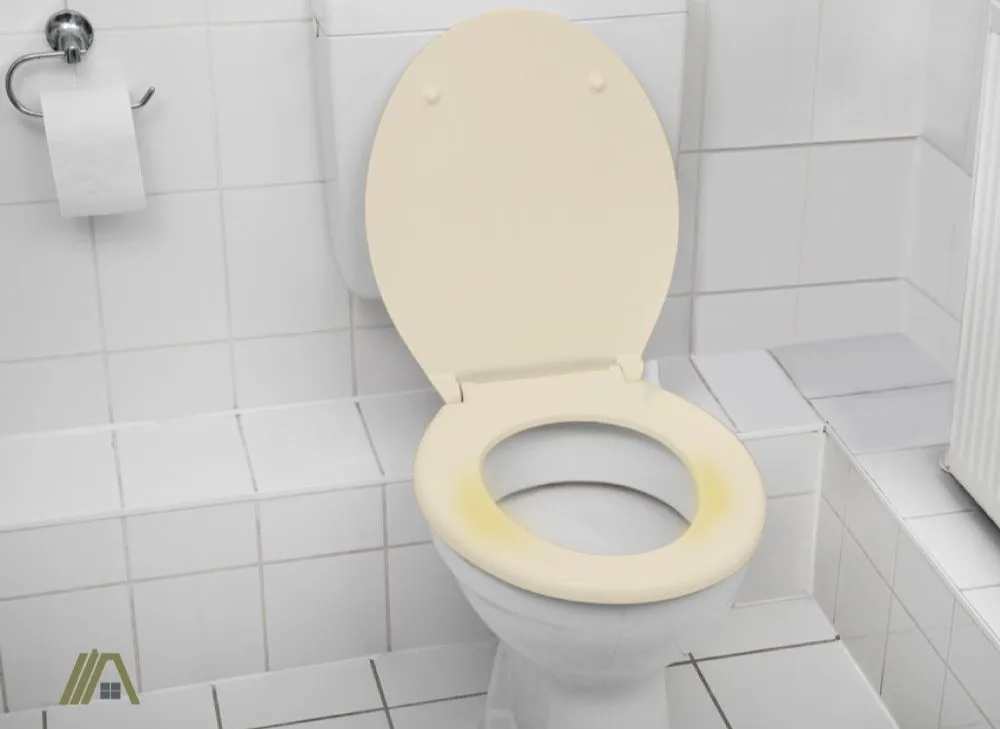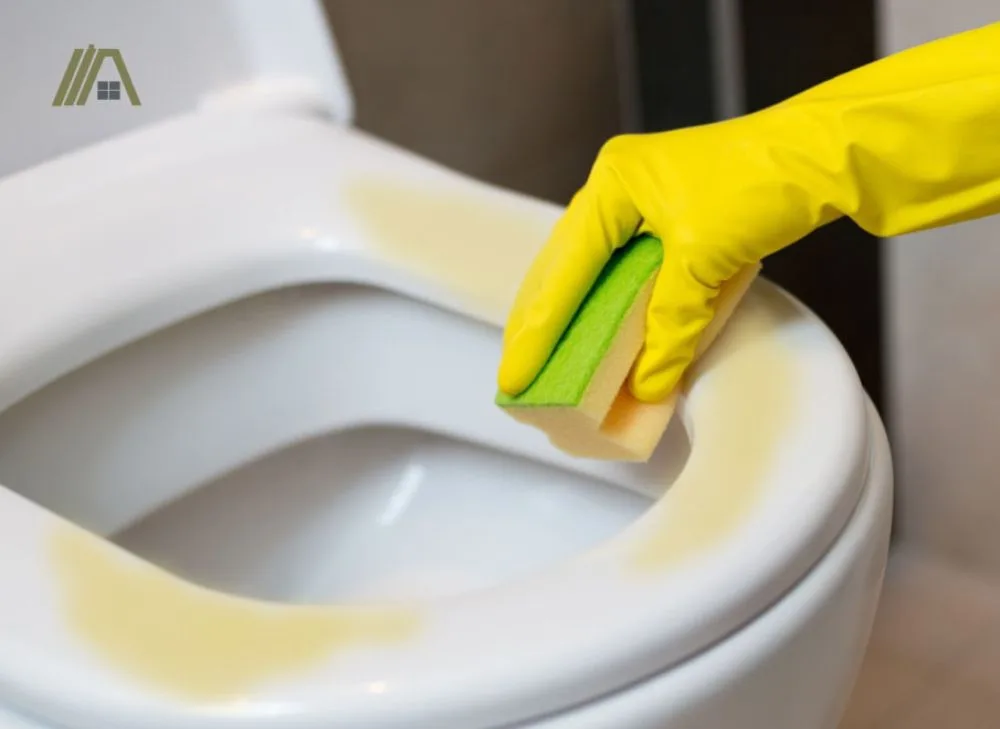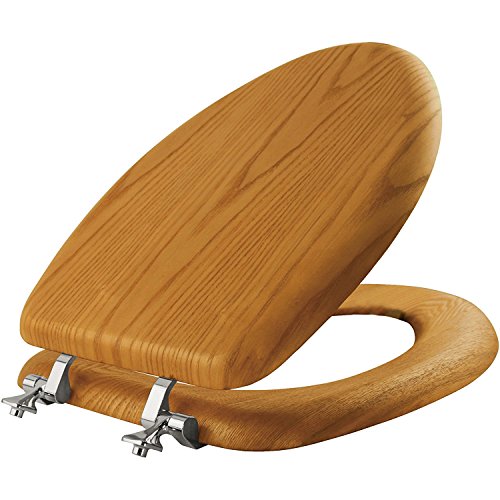Yellow stains in a bathroom are commonly associated with filth, making a toilet look like it hasn’t been cleaned in ages. In actuality, yellow stains do not have to be signs of poor cleaning habits.
Although urine staining, hard water, and harsh chemicals can all lead to yellowing, there is one cause that is the most common. This kind of staining cannot be removed, but it can be prevented or slowed.

Many people think that urine stains cause yellowing of plastic toilet seats. However, the most prevalent cause is aging. Plastics yellow naturally over time. UV rays, harsh chemicals, extreme temperatures, and humidity increase the rate of aging.
Lack of Cleaning Is Not the Most Common Cause
Although it may seem that a lack of cleaning would be the most common cause of plastic toilet seat yellowing, this is not the case.
Lack of cleaning can lead to yellowing, but urine staining is not nearly as widespread as staining due to the aging of the plastic.

Urine staining is caused by urine occasionally splashing up as you are going to the bathroom or as the toilet flushes.
Because urine staining is rare and leads to smaller stains, it cannot account for the majority of widespread plastic toilet seat yellowing.
Most Common Cause Is Aging
Aging for plastic means that the plastic is failing. Whether that looks like discoloration or cracking, it naturally happens for toilet seats made of plastic.
Aging can also be associated with wear and tear since the longer a toilet seat is around, the more wear and tear it will be exposed to.
The wear and tear that plastic toilet seats are exposed to includes ultraviolet (UV) rays, extreme temperature, humidity changes, and harsh chemicals.
Just like our skin is sensitive to UV rays, plastic toilet seats are too. However, instead of turning pink from too much sun exposure, plastic toilet seats turn yellow.
Another similarity between plastic and our skin is that excessive exposure to UV rays can lead to damage associated with aging.
UV rays are the most common cause of aging plastic toilet seats since they are hard to avoid and toilet seats are often exposed to them daily. Comparatively, exposure to extreme temperatures, humidity, and harsh chemicals can be limited and controlled.
Noticeable yellowing often takes a few years to really become noticeable or problematic. When the toilet seat is five to seven years old, the staining might be bad enough to require replacement.
Since UV light, extreme temperatures, humidity, and harsh chemicals can create wear and tear similar to natural plastic aging, they can also be identified as processes that increase the rate of yellowing.
The more sunlight your toilet seat experiences, the sooner you’ll see yellowing, and the worse the yellowing will be.
Harsh chemicals, although they might not be used often, are very powerful accelerants of aging since they damage plastic far more quickly than sunlight does.

Can You Fix a Discolored Toilet Seat?
Although human aging can be somewhat combatted by surgery, it cannot be reversed or fixed. The same goes for plastic toilet seats.
While a urine stain or hard water stain can be cleaned, the damage done to the plastic of a plastic toilet seat is irreparable.
Each microscopic bit of plastic is damaged in a way that would require replacement rather than cleaning. So, the stain runs so deep that it is on a microscopic level.
At this point, it is best to just replace the plastic toilet seat with a new one, especially since they are fairly cheap to replace.
Ways to Prevent/Slow Yellowing in the Future
Avoid Direct Sunlight
Since UV light is the biggest culprit for premature aging of a toilet seat, leading to widespread yellowing, avoiding direct sunlight would be the best way to slow aging and prevent yellowing.
If your bathroom is in the interior of your home and has no windows, you won’t have much of a problem with yellowing due to UV rays.
However, if your bathroom has a window, it would be wise to consider getting curtains to limit the amount of sun exposure your toilet seat gets.
Natural sunlight is always nice in every room of your home, even including your bathroom, so you can open your bathroom window curtains while you’re using the bathroom but when the bathroom isn’t in use, they should stay closed to prevent sun damage.
Put on a Toilet Seat Cover
One way to avoid direct sunlight without blocking the sunlight from entering your bathroom would be to cover the toilet seat itself.
Toilet seat covers (amazon link) can provide decoration, prevent toilet seat slamming, create cushioning, as well as prevent UV damage and slow plastic aging.
One con to toilet seat covers is that they absorb gross bathroom substances unlike plastic, which is mostly impermeable.
Cleaning Methods
Although you cannot remove or repair stains related to plastic aging, there are cleaning methods that can be used to slow the process and avoid using harsh chemicals.
Use Harsh Chemicals Wisely
Unfortunately, the usage of harsh chemicals such as bleach cannot always be avoided entirely since toilet maintenance often requires them.
Despite this, you can use harsh chemicals sparingly if you clean the toilet regularly with more gentle chemicals.
To remove yellow stains that are not age-related, lemon juice, vinegar, and other substances can still do some stain-removal but are not as intense.
If you get rid of non-aging-related stains soon after they develop, the stains will have less time to penetrate the plastic and grow worse over time.
This way, you can still do the cleaning needed without chemicals that will accelerate plastic aging.
Alternative Seat Materials
Rather than taking preventative measures to try to prevent the aging of a plastic toilet seat, instead, you can use a different kind of toilet seat that is resistant to yellowing.
Wood
Wooden toilet seats (amazon link) can come in a variety of different wood types and colors and can match other wood in the home.
Wood is also seen as classy and can add some sophistication to your bathroom, restroom, washroom, toilet, or lavatory.
Toilet seats made of wood are also more resistant to temperature changes. Oftentimes, a wooden seat will be more comfortable at room temperature while a plastic seat can feel cold on bare skin.
Although wood can be classy and comfortable, it has its fair share of disadvantages.
Wood is sensitive to water as well as harsh chemicals.
There is plenty of moisture in the bathroom so, unless you dry the toilet seat after it gets wet, the wood can suffer from water damage.
Harsh chemicals can also damage and stain the wood. To prevent this, you must be very careful what you use on the wooden toilet seat and what is used on the less sensitive bowl of the toilet.
Polyresin
A toilet seat made of polyresin will feel similar to a plastic toilet seat but it will be resistant to UV damage.
Polyresin toilet seats (amazon link) can include all sorts of wild colors and designs. They are especially fun for a child’s bathroom.
Polyresin is also quite light but durable, unlike wood and plastic.
Unfortunately, polyresin can be quite expensive.
Padded Seat
Adding a padded seat (amazon link) can be done on top of any type of toilet seat, including plastic, polyresin, and wood.
They can be added to increase comfort as well as to hide any stains on the seat.
However, they tend to wear down quickly.
Padded toilet seats will have to be replaced more often than any other toilet seat.
While you’re dealing with the yellow toilet seat, why not address sweating yellow walls as well?
Sources
https://www.polymersolutions.com/blog/what-makes-plastic-turn-yellow/
https://www.sunrisespecialty.com/how-to-remove-yellow-stains-from-toilet-bowl



